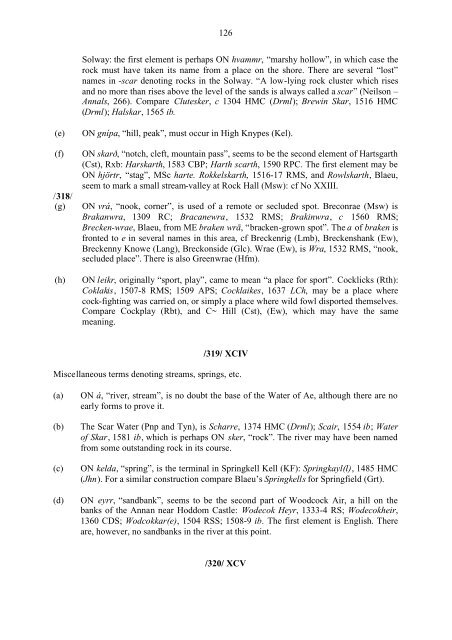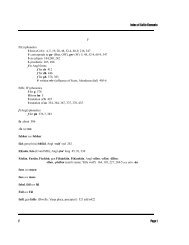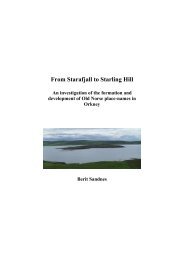May Williamson: The Non-Celtic Place-Names of the Scottish Border ...
May Williamson: The Non-Celtic Place-Names of the Scottish Border ...
May Williamson: The Non-Celtic Place-Names of the Scottish Border ...
You also want an ePaper? Increase the reach of your titles
YUMPU automatically turns print PDFs into web optimized ePapers that Google loves.
126<br />
Solway: <strong>the</strong> first element is perhaps ON hvammr, “marshy hollow”, in which case <strong>the</strong><br />
rock must have taken its name from a place on <strong>the</strong> shore. <strong>The</strong>re are several “lost”<br />
names in -scar denoting rocks in <strong>the</strong> Solway. “A low-lying rock cluster which rises<br />
and no more than rises above <strong>the</strong> level <strong>of</strong> <strong>the</strong> sands is always called a scar” (Neilson –<br />
Annals, 266). Compare Clutesker, c 1304 HMC (Drml); Brewin Skar, 1516 HMC<br />
(Drml); Halskar, 1565 ib.<br />
(e)<br />
(f)<br />
/318/<br />
(g)<br />
(h)<br />
ON gnípa, “hill, peak”, must occur in High Knypes (Kel).<br />
ON skarð, “notch, cleft, mountain pass”, seems to be <strong>the</strong> second element <strong>of</strong> Hartsgarth<br />
(Cst), Rxb: Harskarth, 1583 CBP; Harth scarth, 1590 RPC. <strong>The</strong> first element may be<br />
ON hjörtr, “stag”, MSc harte. Rokkelskarth, 1516-17 RMS, and Rowlskarth, Blaeu,<br />
seem to mark a small stream-valley at Rock Hall (Msw): cf No XXIII.<br />
ON vrá, “nook, corner”, is used <strong>of</strong> a remote or secluded spot. Breconrae (Msw) is<br />
Brakanwra, 1309 RC; Bracanewra, 1532 RMS; Brakinwra, c 1560 RMS;<br />
Brecken-wrae, Blaeu, from ME braken wrā, “bracken-grown spot”. <strong>The</strong> a <strong>of</strong> braken is<br />
fronted to e in several names in this area, cf Breckenrig (Lmb), Breckenshank (Ew),<br />
Breckenny Knowe (Lang), Breckonside (Glc). Wrae (Ew), is Wra, 1532 RMS, “nook,<br />
secluded place”. <strong>The</strong>re is also Greenwrae (Hfm).<br />
ON leikr, originally “sport, play”, came to mean “a place for sport”. Cocklicks (Rth):<br />
Coklakis, 1507-8 RMS; 1509 APS; Cocklaikes, 1637 LCh, may be a place where<br />
cock-fighting was carried on, or simply a place where wild fowl disported <strong>the</strong>mselves.<br />
Compare Cockplay (Rbt), and C~ Hill (Cst), (Ew), which may have <strong>the</strong> same<br />
meaning.<br />
/319/ XCIV<br />
Miscellaneous terms denoting streams, springs, etc.<br />
(a)<br />
(b)<br />
(c)<br />
(d)<br />
ON á, “river, stream”, is no doubt <strong>the</strong> base <strong>of</strong> <strong>the</strong> Water <strong>of</strong> Ae, although <strong>the</strong>re are no<br />
early forms to prove it.<br />
<strong>The</strong> Scar Water (Pnp and Tyn), is Scharre, 1374 HMC (Drml); Scair, 1554 ib; Water<br />
<strong>of</strong> Skar, 1581 ib, which is perhaps ON sker, “rock”. <strong>The</strong> river may have been named<br />
from some outstanding rock in its course.<br />
ON kelda, “spring”, is <strong>the</strong> terminal in Springkell Kell (KF): Springkayl(l), 1485 HMC<br />
(Jhn). For a similar construction compare Blaeu’s Springkells for Springfield (Grt).<br />
ON eyrr, “sandbank”, seems to be <strong>the</strong> second part <strong>of</strong> Woodcock Air, a hill on <strong>the</strong><br />
banks <strong>of</strong> <strong>the</strong> Annan near Hoddom Castle: Wodecok Heyr, 1333-4 RS; Wodecokheir,<br />
1360 CDS; Wodcokkar(e), 1504 RSS; 1508-9 ib. <strong>The</strong> first element is English. <strong>The</strong>re<br />
are, however, no sandbanks in <strong>the</strong> river at this point.<br />
/320/ XCV




